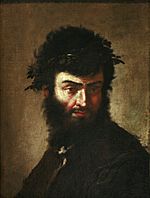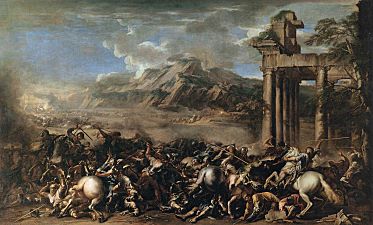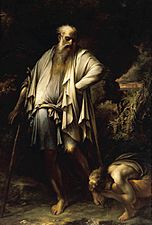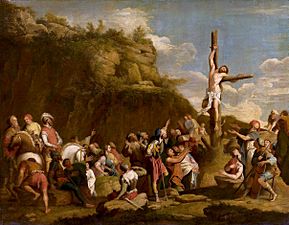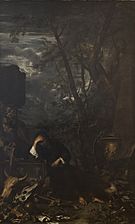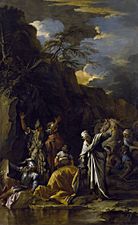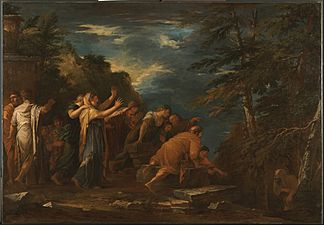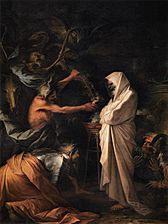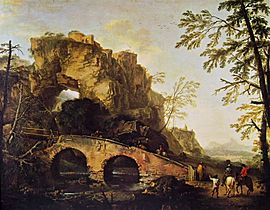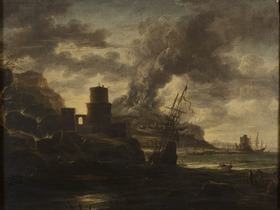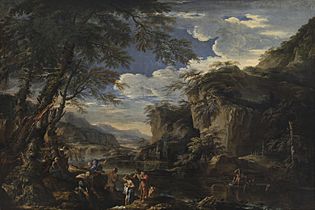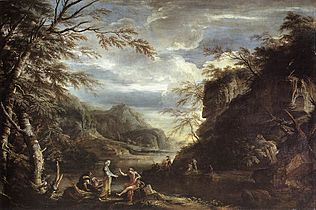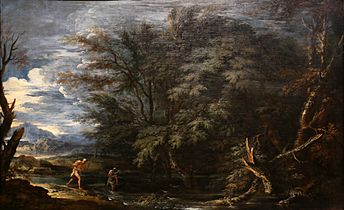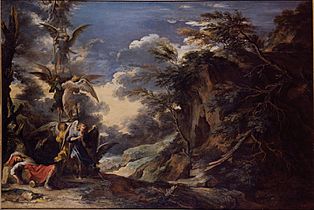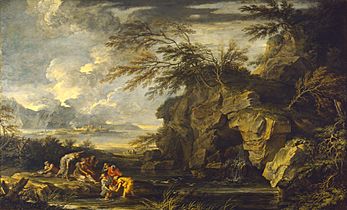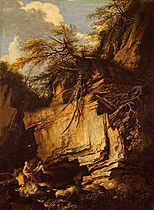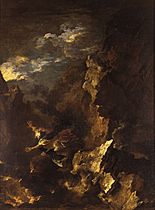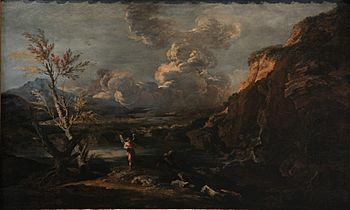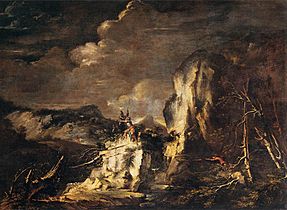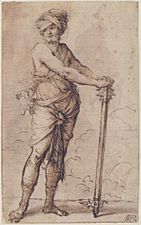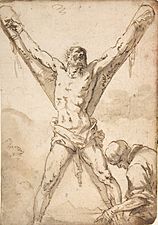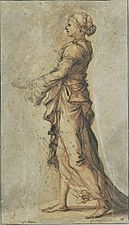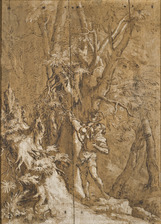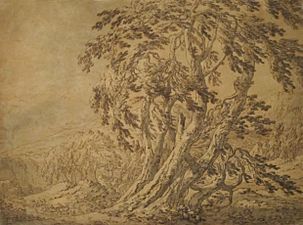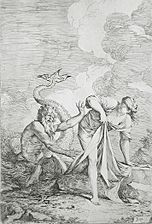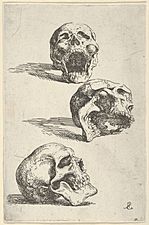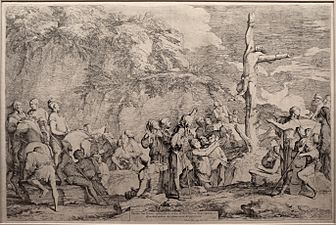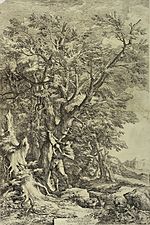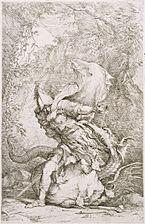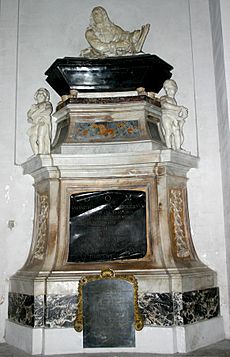Salvator Rosa facts for kids
Quick facts for kids
Salvator Rosa
|
|
|---|---|
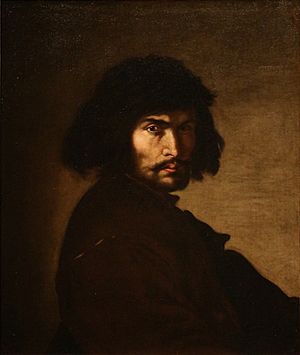
Self Portrait (ca. 1650s), oil on canvas, 75 x 62.5 cm., Detroit Institute of Art.
|
|
| Born | June 20 or July 21, 1615 Arenella, Kingdom of Naples
|
| Died | March 15, 1673 (aged 57) |
| Nationality | Italian |
| Known for | Painting, printmaking, poetry |
| Movement | Baroque |
Salvator Rosa (1615 –1673) is best known today as an Italian Baroque painter, whose romanticized landscapes and history paintings, often set in dark and untamed nature, exerted considerable influence from the 17th century into the early 19th century. In his lifetime he was among the most famous painters, known for his flamboyant personality, and regarded as an accomplished poet, satirist, actor, musician, and printmaker, as well. He was active in Naples, Rome, and Florence, where on occasion he was compelled to move between cities, as his caustic satire earned him enemies in the artistic and intellectual circles of the day.
As a history painter, he often selected obscure and esoteric subjects from the Bible, mythology, and the lives of philosophers, that were seldom addressed by other artists. He rarely painted the common religious subjects, unless they allowed a treatment dominated by the landscape element. He also produced battle scenes, allegories, scenes of witchcraft, and many self portraits. However, he is most highly regarded for his very original landscapes, depicting "sublime" nature: often wild and hostile, at times rendering the people that populated them as marginal in the greater realm of nature. They were the very antithesis of the "picturesque" classical views of Claude Lorrain and prototypes of the romantic landscape. Some critics have noted that his technical skills and craftsmanship as a painter were not always equal to his truly innovative and original visions. This is in part due to a large number of canvases he hastily produced in his youth (1630s) in pursuit of financial gain, paintings that Rosa himself came to loathe and distance himself from in his later years, as well as posthumously misattributed paintings. Many of his peopled landscapes ended up abroad by the 18th century, and he was better known in England and France than most Italian Baroque painters.
Rosa has been described as "unorthodox and extravagant", a "perpetual rebel", "The Anti-Claude", and a proto-Romantic. He had a great influence on Romanticism, becoming a cult-like figure in the late 18th and early 19th centuries, and myths and legends grew around his life, to the point that his real life was scarcely distinguished from the bandits and outsiders that roamed the wild and thundery landscapes he painted. By the mid 19th century however, with the rise of realism and Impressionism, his work fell from favor and received very little attention. A renewed interest in his paintings emerged in the late 20th century, and although he is not ranked among the very greatest of the Baroque painters by art historians today, he is considered an innovative and significant landscape painter and a progenitor of the romantic movement.
Contents
Biography
Early life
Rosa was born in Arenella, at that time in the outskirts of Naples, on either June 20 or July 21, 1615. His mother was Giulia Greca Rosa, a member of one of the Greek families of Sicily. His father, Vito Antonio de Rosa, a land surveyor, urged his son to become a lawyer or a priest, and entered him into the convent of the Somaschi Fathers. Yet Salvator showed a preference for the arts and secretly worked with his maternal uncle Paolo Greco to learn about painting. He soon transferred himself to the tutelage of his brother-in-law Francesco Fracanzano, a pupil of Ribera, and afterward to either Aniello Falcone, a contemporary of Domenico Gargiulo, or to Ribera. Some sources claim he spent time living with roving bandits. At the age of seventeen, his father died; his mother was destitute with at least five children and Salvator found himself without financial support and the head of a household looking to him for support.
He continued apprenticeship with Falcone, helping him complete his battlepiece canvases. In that studio, it is said that Giovanni Lanfranco took notice of his work, and advised him to relocate to Rome, where he stayed from 1634 until 1636.
Returning to Naples, he began painting haunting landscapes, overgrown with vegetation, or jagged beaches, mountains, and caves. Rosa was among the first to paint "romantic" landscapes, with a special turn for scenes of picturesque, often turbulent and rugged scenes peopled with shepherds, brigands, seamen, soldiers. These early landscapes were sold cheaply through private dealers.
He returned to Rome in 1638–39, where he was housed by Cardinal Francesco Maria Brancaccio, bishop of Viterbo. For the Chiesa Santa Maria della Morte in Viterbo, Rosa painted his first and one of his few altarpieces, the Incredulity of Thomas.
Wife and family
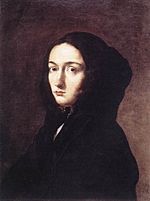
In 1640, Rosa met Lucrezia Paolini (ca. 1620–1696) in Florence. Lucrezia was a married woman, whose husband had left the city and abandoned her soon after their marriage, never to return. She served as a model for Rosa on occasions, and was likely the model for the allegory of Music (ca. 1641). Rosa and Lucrezia soon became dedicated and lifelong companions. Their first son Rosalvo was born in August 1641, probably in Volterra, and another son Augusto was born in 1657. Records show at least four more children were born and placed with foundling hospitals between 1641 and 1657, giving some indication of their struggling financial conditions in those years. The custom of unmarried couples living together was not too uncommon in the early years of the 17th century, but as the decades passed the church grew less and less tolerant of the practice. At times Rosa's prominent reputation and relationships to powerful patrons helped to shield him from the Inquisition. At other times, the situation left him vulnerable to the many rivals and enemies he made through his satires and ostentatious character. In 1656, feeling pressure in Rome from the poet Agostino Favoriti and his close ally Fabio Chigi, recently elected Pope Alexander VII, Rosa sent Lucrezia and their son Rosalvo to stay in Naples with his family. Soon after she arrived, a severe outbreak of the plague hit Naples, and Rosalvo, Salvator's brother, sister, brother-in-law and their children all died in the epidemic. Lucrezia survived however and returned to Rome alone. The following year their son Augusto was born. Near the end of his life, declining in health and anticipating death, Rosa married Lucrezia on March 4, 1673. On March 17 he died. An inventory of Rosa's house taken in 1673 shortly after his death, indicated the Portrait of Lucrezia Paolini was hanging in a prominent location in the home, and one of the few paintings in his possession when he died.
Career
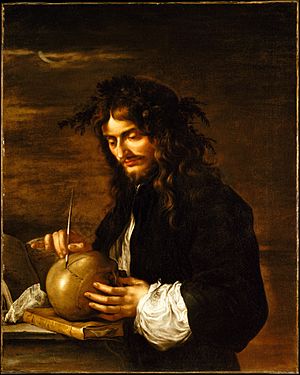
While Rosa had a facile genius at painting, he pursued a wide variety of arts: music, poetry, writing, etching, and acting. In Rome, he befriended Pietro Testa and Claude Lorrain. During a Roman carnival play he wrote and acted in a masque, in which his character bustled about Rome distributing satirical prescriptions for diseases of the body and more particularly, of the mind. In costume, he inveighed against the farcical comedies acted in the Trastevere under the direction of Bernini.
While his plays were successful, this activity also gained him powerful enemies among patrons and artists, including Bernini himself, in Rome. Around 1640, he accepted an invitation from Giovanni Carlo de' Medici to relocate to Florence, where he stayed until 1649. Once there, Rosa sponsored a combination of studio and salon of poets, playwrights, and painters—the so-called Accademia dei Percossi (Academy of the Stricken). To the rigid art milieu of Florence, he introduced his canvases of wild landscapes; while influential, he gathered few true pupils. Another painter poet, Lorenzo Lippi, shared with Rosa the hospitality of the cardinal and the same circle of friends. Lippi encouraged him to proceed with the poem Il Malmantile racquistato. He was well acquainted also with Ugo and Giulio Maffei, and was housed with them in Volterra, where he wrote four satires Music, Poetry, Painting, and War. About the same time he painted Philosophy, now in the National Gallery, London.
A passage in one of his satires suggests that he sympathized with the 1647 insurrection led by Masaniello—whose portrait he painted, though probably not from life. Rosa's tempestuous art and reputation as a rebel gave rise to a popular legend—recounted in a biography of Rosa published in 1824 by Sydney, Lady Morgan—that Rosa lived with a gang of bandits and participated in the uprising in Naples against Spanish rule. Although these activities cannot be conveniently dovetailed into known dates of his career, in 1846 a famous romantic ballet about this story titled Catarina was produced in London by the choreographer Jules Perrot and composer Cesare Pugni.
He returned to stay in Rome in 1649. Here he increasingly focused on large-scale paintings, tackling themes and stories unusual for seventeenth-century painters. These included Democritus amid the Tombs, The Death of Socrates, The Death of Regulus (these two are now in England), Justice Quitting the Earth and the Allegory of Fortune. This last work raised a storm of controversy among religious and civil authorities who perceived in it a satire directed at them and Rosa was nearly arrested. It was about this time that Rosa wrote his satire named Babylon.

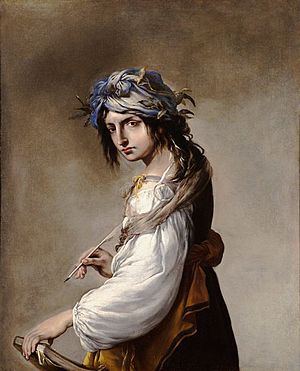
His criticisms of Roman art culture won him several enemies. An allegation arose that his published satires were not his own, but Rosa vehemently denied the charges. It may be possible that literary friends in Florence and Volterra coached him about the topic of his satires, while the compositions of which remained nonetheless his own. To confute his detractors he wrote the last of the series, entitled Envy.
Among the pictures of his last years were the Saul and the Witch of Endor and Battlepiece now in the Musée du Louvre, the latter painted in 40 days; Polycrates and the Fishermen; and the Oath of Catiline (Palazzo Pitti).
While occupied with a series of satirical portraits, to be closed by one of himself, Rosa was assailed by dropsy. He died a half year later. In his last moments he married Lucrezia, who had borne him two sons, one of them surviving him. His tomb is in Santa Maria degli Angeli e dei Martiri, where a portrait of him has been set up. Salvator Rosa, after struggles of his early youth, had successfully earned a handsome fortune.
He was a significant etcher, with a highly popular and influential series of small prints of soldiers, and a number of larger and very ambitious subjects.
Among his pupils were Evangelista Martinotti of Monferrato and his brother Francesco. Another pupil was Ascanio della Penna of Perugia.
Legacy
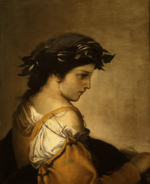
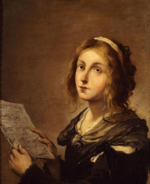
During Rosa's lifetime his work inspired followers such as Giovanni Ghisolfi, but his most lasting influence was on the later development of romantic and sublime landscape traditions within painting. Eighteenth-century artists influenced by Rosa include Alessandro Magnasco, Andrea Locatelli, Giovanni Paolo Panini and Marco Ricci. As Wittkower states, it is in his landscapes, not his grand historical or religious dramas, that Rosa truly expresses his innovative abilities most graphically. Rosa himself dismissed his early landscapes as frivolous capricci in comparison to his history paintings and later work, but the academically conventional history canvases often restrained his rebellious streak. He generally avoided the idyllic and pastoral calm country-sides of Claude Lorrain and Paul Bril in his landscapes, and created brooding, melancholic fantasies, awash in ruins and brigands. By the eighteenth century, the contrasts between Rosa and the "sublime" landscape, and artists such as Claude and the "picturesque" landscape, were much remarked upon. A 1748 poem by James Thompson, "The Castle of Indolence", illustrated this: "Whate'er Lorraine light touched with softening hue/ Or savage Rosa dashed, or learned Poussin drew".
In a time when artists were often highly constrained by patrons, Rosa had a plucky streak of independence, which celebrated the special role of the artist. He refused to paint on commission or to agree on a price beforehand, and he chose his own subjects. In his own words, he painted "...purely for my own satisfaction."
Salvator Rosa and romanticism
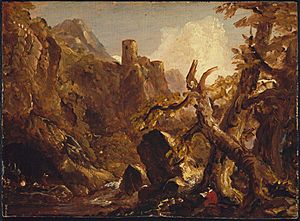
Rosa's influence on romanticism in the late 18th and early 19th centuries was profound. Art historians have described him as a "cult figure", who "inaugurated the romantic landscape", an initiator of the "cult" of the sublime landscape. One of the earliest manifestations of the romantic movement to emerge in the early 18th century was the English landscape garden, and the paintings of Rosa, as well as Claude Lorrain and Nicolas Poussin were key inspirations and models. William Kent, who originated the naturalized garden was known to be a great admirer of Rosa and went so far as to plant dead trees in his gardens to achieve Salvator Rosa effects.
One historian noted "An extraordinary amount of Rosa's fame and influence in England seems to have rested on verbal and literary transmission, and had an impact that extended far beyond the borderline of purely pictorial concerns." In A Philosophical Enquiry into the Origin of Our Ideas of the Sublime and Beautiful (1757), Edmund Burke designated Salvator Rosa as the "painter of the Sublime". Horace Walpole, Sir Joshua Reynolds, and Percy Bysshe Shelly wrote highly of his paintings. "His name came to be a kind of code word for the qualities most appreciated by the romantics.....savage sublimity, terror, grandeur, astonishment, and pleasing horror" A number of accounts of Rosa's life were published purporting to be biographies, often including fictionalized anecdotes. Salvator Rosa was the subject of an opera by Antônio Carlos Gomes, a ballet Catarina or La Fille du Bandit, and Franz Liszt included an arrangement of a song by Giovanni Bononcini, in his suite Annees de pelerinage, Deuxieme annee: Italie, (S.161) No. 3, Canzonetta del Salvator Rosa.

Rosa and his tempestuous spirit became the darling of British Romantics such as Henry Fuseli, John Hamilton Mortimer, and Alexander Runciman. His influence can be seen in the work of artist such as John Martin, who studied Rosa's work in his formative years, A recent exhibit of William Turner's work, at the Prado museum in Madrid, notes the influence Rosa had on Turner's landscapes. Rosa's influence can also be seen in American art of the period. Thomas Cole counted Rosa among his heroes, and his impact has been identified in the work of artist such as Washington Allston, George Caleb Bingham, Thomas Moran, William Sidney Mount, John Trumbull, Benjamin West and other American artist.
Rosa's reputation and influence waned in the nineteenth century; when his Monks Fishing was displayed in Dulwich in 1843 it was criticized by John Ruskin as telling "unmitigated falsehoods" and containing "laws of nature set at open defiance". Since the 1970s, Rosa's work has received renewed attention from scholars. including museum exhibitions, a catalog raisonné, catalogs of his drawings, the publication of his letters, biographical works, and other volumes ranging from paperback picture books to scholarly monographs.
Galleries
Paintings
-
Portrait of a Man (1640s), oil on canvas, 78 x 65 cm., Hermitage Museum)
-
Heroic Battle (ca. 1652–1664), oil on canvas, 214 x 351 cm. Louvre
-
Human Fragility (ca. 1656), oil on canvas, 199 x 134 cm., Fitzwilliam Museum
-
Diogenes Casting Away his Cup (1650s), oil on canvas, 219 x 148 cm., private collection
-
Democritus in Meditation (1650–51), oil on canvas, 344 x 214 cm., National Gallery of Denmark
-
The Death of Regulus (ca. 1650–1652), oil on canvas, 152.4 × 219.71 cm., Virginia Museum of Fine Arts
-
The Baptism of the Eunuch (ca. 1660), oil on canvas, 200 x 122 cm., Chrysler Museum of Art
-
Pythagoras Emerging from the Underworld (1662), oil on canvas, 131 x 189 cm., Kimbell Art Museum
Landscapes
-
Saint John the Baptist Baptizing Christ in the Jordan (ca. 1655) oil on canvas, 173 x 258.7 cm., Kelvingrove Art Gallery and Museum
-
Saint John the Baptist Revealing Christ to the Disciples (ca. 1655) oil on canvas, 173.4 x 260.7 cm., Kelvingrove Art Gallery and Museum
-
Bandits on a Rocky Coast (ca. 1655), oil on canvas, 74.9 x 100 cm., Metropolitan Museum of Art
-
Apollo and the Cumean Sibyl (1657–58), oil on canvas, 173.7 x 259.5 cm., Wallace Collection
-
Mercury and the Dishonest Woodsman (ca. 1663), oil on canvas, 125.7 x 202.1 cm., National Gallery
-
The Finding of Moses (1660–65), oil on canvas, 123.2 × 202.6 cm., Detroit Institute of Arts
-
The Death of Empedocles (ca.1665–70), oil on canvas, 135 x 99 cm., private collection
-
Rocky Landscape with a Huntsman and Warriors (ca. 1670), oil on canvas, 142 x 192 cm., Louvre
Drawings
All drawings are undated: pen, ink, and wash; or pen, ink, wash, and chalk on paper
-
Turbaned Warrior Holding a Mace (13.2 x 8.2 cm.), Metropolitan Museum of Art
-
Martyrdom of St. Andrew (19.8 x 13.7 cm.), Metropolitan Museum of Art
-
Woman standing draped (25.4 x 14.7 cm.), Louvre
-
Forest Scene, Honolulu Museum of Art
Prints
All prints are etchings, or etchings with drypoint
Works about Rosa
A number of biographies and fictionalizations of the life of Rosa exist:
- Domenico Passeri speaks of him in Vite de Pittori
- Salvini, Satire e Vita di Salvator Rosa
- Bernardo de' Dominici, Vita di Rosa (1742, Naples)
- In England, Lady Morgan in The Life and Times of Salvator Rosa, and Albert Cotton in A Company of Death romanticized his life.
- Rosa is the fictional hero of the novella Signor Formica, 1819, also known simply as Salvator Rosa, by E. T. A. Hoffmann.
- Salvator Rosa is a 19th-century Italian opera by Antônio Carlos Gomes, with libretto by Antonio Ghislanzoni, after the novel Masaniello by Eugène de Mirecourt.
- The 1846 ballet Catarina by the choreographer Jules Perrot and the composer Cesare Pugni was produced in London at Her Majesty's Theatre, and was inspired by the alleged story of Rosa's dealings with Brigands of the Abruzzi.
- One of the pieces included in the piano collection Années de pèlerinage by Franz Liszt is entitled "Canzonetta del Salvator Rosa". That song (Vado ben spesso cangiando loco) was, however, composed by Giovanni Bononcini.
See also
 In Spanish: Salvator Rosa para niños
In Spanish: Salvator Rosa para niños


